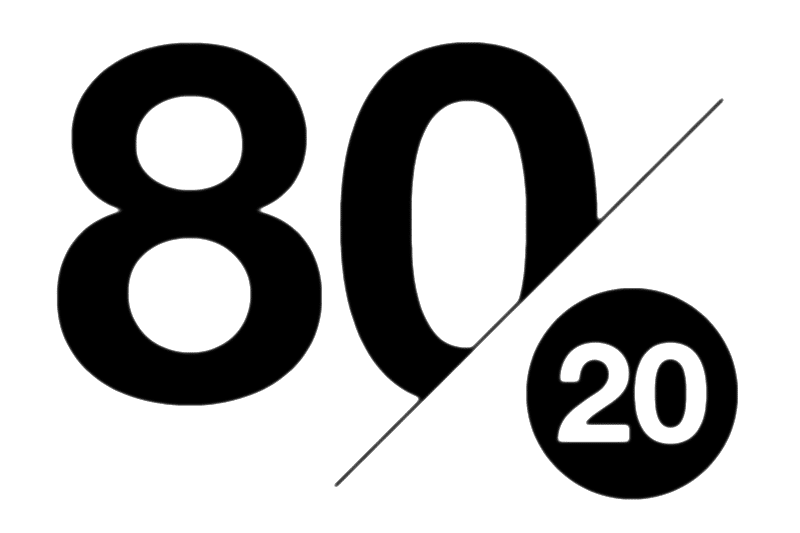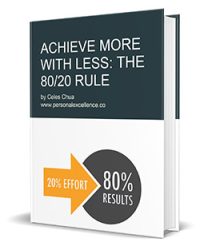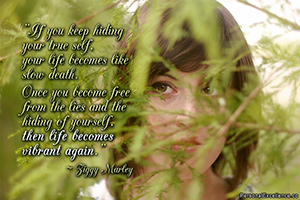
This is part 1 of a 3-part series on the 80/20 rule and how you can achieve more with less in life with it.
- Part 1: The 80/20 Rule: How To Achieve More With Less In Life
- Part 2: Why You Should Not Resist The 80/20 Rule
- Part 3: Apply 80/20 to Your Life Now in 3 Simple Steps

(Image: Personal Excellence)
“Conventional wisdom is not to put all of your eggs in one basket. 80/20 wisdom is to choose a basket carefully, load all your eggs into it, and then watch it like a hawk.” — Richard Koch, The 80/20 Principle
Today I am going to share the power of using the 80/20 rule in your life. While I initially used it at work, I later realized that it applies to all aspects of our life — from relationships to habits to health — and there are great rewards from applying it.
What is the 80/20 Rule?
Imagine you are the CEO of a company and you have a salesforce. In a world where everything is equal, you will assume that everyone contributes to your sales proportionately, i.e. 20% of the staff bring in 20% of the sales, 50% of the staff bring in 50% of the sales, and 80% bring in 80% of the sales.
But what if instead of a 1-1 relationship, you realize that 80% of your sales actually come from 20% of your salesforce?
The 80/20 Rule

(Image: Personal Excellence)
This is the 80/20 rule — where 80% of the results in a situation come from 20% of the causes. This phenomenon was first discovered by Vilfredo Pareto, an Italian Economist who found that approximately 80% of the land in Italy was owned by 20% of the population. He first observed this principle while gardening and noticed that 20% of the peapods yielded 80% of harvested peas.
This 80/20 effect is also known as the Pareto principle, the 80/20 principle, and the law of the vital few, where “vital few” refers to the vital few factors that contribute to much of the outcome.
Examples of 80/20 in Action
Here are some of many situations where the 80/20 rule can be observed:
- Population: 80% of the population in England (25.8 million out of 32.3 million) come from 20% of its cities (53 out of 263 cities).
- Resource Consumption: 70% of the world’s energy, 75% of its metals, and 85% of its timber are consumed by 20% of the world’s countries (these countries have less than 20% of the world’s population).
- Natural Resources: 80% of Earth’s minerals are found in less than 20% of its surface.
- Wealth: 85% of total global assets are owned by 10% of adults.[1]
- Crimes: A large percentage of crimes tends to be committed by repeat offenders, which make up a small proportion of the overall population. In Sweden, 1% of the population is responsible for 63% of violent crime.[2]
- Books: 80% of the value in a book can be gained from 20% of its content.
- Clothes: Most of the time you wear the same few clothes in your wardrobe.
- Divorces: A small proportion of married individuals are responsible for a higher than proportionate share of divorces, which is also why many more second and third marriages fail compared to first marriages.[3]
- Consumption: In every industry, a small selection of brands dominates the world’s consumption, e.g., Coca-Cola and Pepsi for sodas, Microsoft Windows and Macintosh for operating systems, and Samsung and iPhone for mobile phones.[4]
- Daily Life: When you eat out, you usually dine at the same few restaurants.
- Smoking: 100% of cigarette consumption is by nearly 20% of the world’s population.[5]
- Business: 80% of sales tend to come from 20% of customers (your loyal customers who love your work). 80% of complaints tend to come from 20% of customers.
- Relationships: 80% of the happiness and value you get from relationships is from 20% of the people you know (your close friends, family, partner).
- Goal achievement: 80% of the results in your goal are from 20% of your actions (meaning a few vital tasks contribute to the biggest results in your goal).
…. and so on.
Applying the 80/20 Rule to Our Life
The 80/20 rule tells us that a large proportion of results is due to a small portion of causes.
- 20% of input in a situation leads to 80% of total output. I call these the 20% high-value tasks, because they create high value in your life.
- On the other hand, 80% of input leads to only 20% of total output. I call these the 80% low-value tasks. Low-value because even when you do them and do them perfectly, they do not add much value to your life.

(Image: Personal Excellence)
It doesn’t have to be exactly 80-20 — for example, 70% of output can be caused by 30% of input, or 60% of output can be caused by 40% of input. The percentages of input and output don’t have to add up to 100 percent either — 70% of output can be caused by 20% (vs. 30%) of input. It just happened that Pareto’s observation was 80-20 (rather than 70-20 or 60-10).
The point is to know that (a) the relationship between input and output is often not 1:1, and (b) some inputs have far more impact than others.
The 80/20 rule has two implications for us.
Fact #1: Understanding that Less is More
Firstly, not everything is equal. No matter what you do, there are always a few vital tasks that matter more. You want to focus on the vital few, the 20% high-value tasks, rather than spread yourself thin.
This is also known as “Less is More” where doing less will net you more results. This is the same as being effective rather than efficient, something that I talk about in my time management posts.
Applying “Less is More” means asking yourself:
- How can I remove the tasks that do not create as much value?
- How can I focus my energy on activities that make me happier and more fulfilled?
Fact #2: Achieving More with Less
Our society today has a “More with More” mindset. We are told that we need to do more to be more. If we’re not doing more, we are losers. So we straddle multiple responsibilities, have our hands constantly full, and have to-do lists so long that they extend to the next 3 months.
But the more we do, the more exhausted we are. As we try to keep up with never-ending needs and responsibilities, our health wanes, our social life suffers, and all the extra money we earn goes into paying for more expenses and loans. For all the time we spend doing more and more, we sure do not seem to be getting more in return.
What if we don’t achieve “More with More”? What if we really achieve “More with Less” — where we make more progress by focusing on the vital few? By channeling all our energy to the things that matter and not by trying to chase every shiny thing?
The 80/20 rule is about how to get more out of your life. When you scale back on the things that aren’t important, you get more time for the things that are. When you cut away tasks that drain you, you have more time and energy for the things that matter.
In the end, the goal of the 80/20 is to achieve more with less, so that we can make the most out of our time on Earth. To focus on what gives us the most meaning, so that we can be fulfilled and happy.
In the next part, I share the 6 common misconceptions people have about the 80/20 rule. Read Part 2 here: 6 Common Misconceptions of The 80/20 Rule
This is part 1 of a 3-part series on the 80/20 rule and how you can achieve more with less in life with it.








![Your Plans vs. Universe's Plans For You [Infographic]](https://personalexcellence.co/files/infographic-your-plans-vs-universe-plans-200x146.png)

 Thanks for reading. If you like my free articles, join my private email list and get my latest updates and articles sent right to your inbox.
Thanks for reading. If you like my free articles, join my private email list and get my latest updates and articles sent right to your inbox.